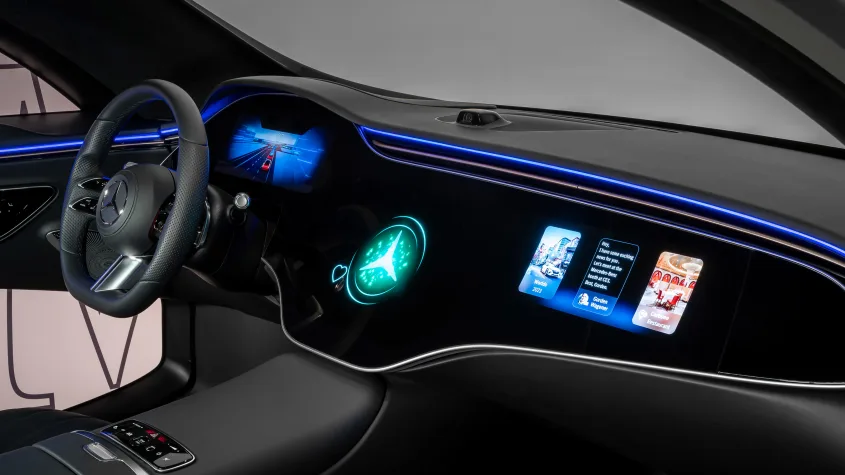We find out how connectivity will shape the upmarket Mercs of the future.
Mercedes used the recent Consumer Electronics Show (CES) in Las Vegas to showcase its latest technology. From enhanced voice control using AI as part of the MBUX operating system, to next generation audio and even music that’s ‘remixed’ while you’re on the move (featuring input from Black Eyed Pea will.i.am), all of these functions are designed to build on Mercedes’ objective to offer ‘digital luxury’ in its cars. We spoke to Magnus Ostberg, chief software officer, to get some insights into the new technology.
Q&A: Magnus Ostberg, Mercedes-Benz chief software officer
Q: With the arrival of your latest operating system software, there’s more connectivity than ever for Mercedes’ cars. Can you tell us about the highlights?
A: This new architecture means we can add more content and services that we couldn’t do before, and it’s going to roll out to all vehicles regardless of it being combustion-engined or electric.
We have a surround navigation system that can share information such as the in-car sensor data, so that you can have a more contextual awareness when driving, making sure that when you turn, not only do you see where you’re supposed to go, you also get the context of the surroundings around you, the buildings, and all the objects in your way, making it a safer, more intuitive experience.
Moving over to the passenger side, with the 3D graphics we now have, you can really bring different experiences to life. You can create melodic song drives, you can actually mix and shake up the music, like DJs do in clubs, and create a different version of the song that you love. And then there is this aspect of just immersive entertainment. We bring partners in that believe in our vision that one plus one equals more than two and you elevate the experience.
If you listen to an audiobook, then you can of course listen to it at home, but if you’re in an immersive experience in the car it becomes something that you’re really enjoying. That’s what we’re trying to do, we’re trying to elevate the experience to a different level. And we believe that is what digital luxury is. It’s a path that fits Mercedes, it fits our customers and they can afford to pay for elevated experience. It’s not a strategy for everybody, but is one that we believe strongly works for Mercedes.
Q: With so much attention on ‘experiences’ in the car, are you looking towards autonomy, with these new features? Because from another point of view it could offer the potential for driver distraction.
A: There’s two aspects to this. The first is that the data Mercedes receives shows us that more of our customers have a desire to consume content at standstill, such as when you’re charging an EV. And we also see that people stay in the driveways to finish listening to audiobooks. In China, they actually use their car as a spa, before they go to their home after work – they stay in the car, so that’s a concrete need today.
Secondly, since we have taken this approach of level three autonomy, once that’s activated, then you’re a passenger and driver distraction is not a problem. We have that implemented already today, so when you’re in level three, the video streaming capabilities turn on, and you can have a teams call with presentations and pictures of everybody in there. It means you can be productive, or you can consume a movie or other kinds of social interaction.
Q: With the latest E-Class, there is the option of multiple screens on the dashboard – do you think we’ve reached peak screen? And do you hear from customers about the need to reintroduce buttons to the dashboard?
A: I think customer usage and feedback is really central to what we’re developing right now. In some cases, the quickest, easiest way is with the scroll wheel, when controlling volume, for example. In other cases, it’s touch that is the most intuitive, and we see this from the data.
When it comes to the number of screens, we’re in the luxury segment, and we believe that with the technology at hand today we believe that a graphical representation is extremely important. At the moment we believe this is the best way to do that. In the future I’m sure there’s going to change, because there are other technologies coming, but today screens are the best way to give that level of quality that we stand for.
Q: What’s your opinion on subscription features? Would you use a monthly model such as rivals BMW are offering? Because it’s been seen as controversial to do this.
A: Our philosophy is that Mercedes is going to offer a luxury experience, so we’re not going to nickel and dime our customers. There will be subscriptions to packages, but we believe that our customers don’t want it to be in their face. It’s not what our customers are looking for.
Q: With MBOS, you’ve worked as a standalone company to develop the software, but as a legacy car manufacturer, how far do you think you can go in that direction?
A: Our goal is really to be a systems provider, we don’t believe that selling software is something that we’re ever going to be. We believe that our value is to provide the combination of the physical world and the digital world and having an elevated experience.
Yes we’ve hired a lot of software engineers to be able to infuse that into the DNA of Mercedes, but we will never be a pure software company, that’s not our goal. We want to be a systems company.




